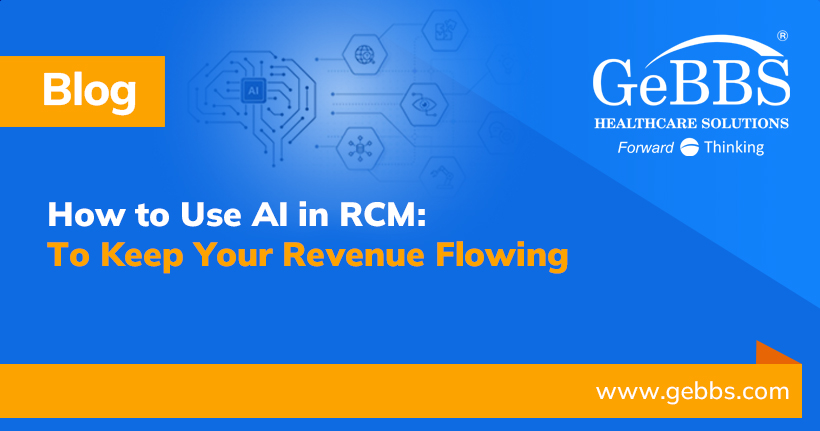It’s 8:15 on a Monday morning and your inbox is already full with payer rejections. A claim you swore was clean has come back denied. Another sits in limbo, waiting on a status update from a portal your staff has logged into three times already. The team’s shoulders slump, coffee cups are refilled, and you can feel the collective sigh…here we go again.
Sound familiar? This is the daily grind of revenue cycle management. Exhausting. Costly. And worst of all? It chips away at margins you’ve worked so hard to protect. Talk about demoralizing.
But it doesn’t have to stay this way. AI in RCM is reshaping health systems in practical, targeted ways that keep cash moving. How can you put this revolutionary technology to work for your organization? Follow this six step process.
Step 1: Automate Claims Status Checks
Few things drain time like chasing down claim statuses. Staff can spend hours every week logging into payer portals, clicking through screens, and waiting for answers that may or may not shed light on why revenue is stuck in limbo. It’s tedious and delays everything else on their plate.
AI-driven bots take that grind off the table. Instead of human eyes staring at screens, automation continuously checks claims across multiple payers and sends real-time alerts when something stalls. Imagine a bot tapping your shoulder the instant a claim slips into “pending” or “denied” status. That’s time reclaimed. And it’s often the first big “aha” moment for teams adopting AI in RCM.
Step 2: Use Predictive Denial Analytics
Denials are of course frustrating. But more importantly, they’re expensive. They create rework and delay cash flow, all while chipping away at morale. What’s surprising, though, is how predictable many denials really are. How many times have you seen common patterns like missing documentation, coding mismatches, and eligibility oversights repeat themselves?
AI thrives in that pattern-recognition space. Trained on years of claim history, predictive models can flag which claims are at risk before they even go out the door. Think of it as a second look after scrubbing, and it doesn’t cost any of your staff’s time. It does, however, catch the mismatches and missing details traditional edits often miss, resulting in fewer denials and far less rework.
Step 3: Improve Coding Accuracy with AI-Assisted Tools
Coding is the backbone of reimbursement. But even the sharpest coders can miss details when under pressure, and documentation isn’t always as clear as it should be. The result? Errors that slow down payment, or worse, draw unwanted audit attention.
AI-assisted coding tools act like a second set of eyes—fast, tireless, and relentlessly consistent. They scan clinical notes and surface the most accurate codes. The coder is still in control, but with a safety net that reduces errors and keeps claims cleaner on the first pass.
For example, let’s say a coder reviews a complex cardiology note. AI instantly pulls out terms like “angioplasty” and “stent placement,” suggests the correct CPT codes, and flags secondary diagnoses that could otherwise slip by. Instead of hunting for needles in a haystack, the coder simply validates and can then move forward with confidence.
Step 4: Streamline Payment Posting and Reconciliation
Once payments finally come in, the work isn’t over. Manual posting and reconciliation can drag out the process of recognizing revenue. Staff sift through remittances and match line items, often juggling multiple systems that don’t talk to each other. Simply put, this is a slow, clunky process. It also increases the risk of missed postings and hidden write-offs.
AI in RCM eliminates that slog. AI tools read remittances automatically, match payments to the correct claims, and reconcile discrepancies in real time. Within hours, leadership can see exactly what’s been paid and where follow-up is needed. That kind of visibility breeds confidence. When books are clean and up-to-date, decisions come quicker and with greater clarity.
Step 5: Unlock Real-Time Insights with AI Dashboards
Too many revenue cycle leaders feel like they’re operating in the dark. Traditional reports show up weeks late, by which point problems have already grown roots. When data finally arrives, revenue has already slipped and leaders are left asking, “Why didn’t we see this coming?” AI in RCM changes that.
AI-driven dashboards provide immediate insights. Instead of static reports, leaders get real-time views into denial patterns, cash flow forecasts, and operational bottlenecks. Think of it as moving from a rearview mirror to a live traffic camera. Instead of reacting to what already happened, you can see issues as they unfold and act before they spiral.
That shift can feel almost unsettling at first. Suddenly, you’re not waiting for monthly reports. You’re watching the revenue cycle play out in real time. Once teams adapt, it becomes hard to imagine going back.
Step 6: Reduce Staff Burnout by Offloading Repetitive Tasks
Behind every stalled claim and denied payment is a team working long hours under relentless pressure. Burnout is a hidden tax on the revenue cycle. Overloaded staff make more mistakes, morale drops, and turnover costs add up.
In this way, AI in RCM protects your people’s peace of mind. By taking on repetitive, low-value tasks, AI frees staff to focus on higher-value work. Imagine a team that used to spend Mondays buried in portal logins. With automation in place, those hours are cut in half. Suddenly, staff have the bandwidth to tackle strategic projects or follow up on high-dollar claims. Both morale and retention improve. And the financial and human aspects of the cycle flow more smoothly.
A Clearer Path Forward with AI in RCM
Monday morning is here again. Now imagine what it’s like after following the steps above. Gone are the denials piling up and endless portal logins. No longer are you face to face with a weary team letting out a collective sigh. No, no. Your reality is far different now.
On this Monday morning, claims move smoothly. Dashboards give you a real-time view of what’s happening, so surprises don’t sneak up weeks later. And your staff? They walk in knowing they’ll spend their time solving problems rather than chasing them. The energy has shifted. And the results speak for themselves.
Today, cash flow is steady. And instead of dreading the next denial report, you’re leading with confidence, knowing revenue is protected and your team is thriving. That’s the power of integrating AI in RCM. It transforms not just the numbers, but the everyday experience of managing them. An AI future doesn’t have to stay hypothetical. GeBBS helps revenue cycle leaders bring it to life with AI-enabled solutions designed for the realities of today’s RCM. From predictive denial analytics to automated payment posting, our technology and expertise work together to keep claims moving, cash flowing, and teams focused on what matters most. With GeBBS as your partner, you get more than cutting-edge tools. You get a smoother, smarter revenue cycle that gives you confidence in your numbers. Contact us today to learn more.






